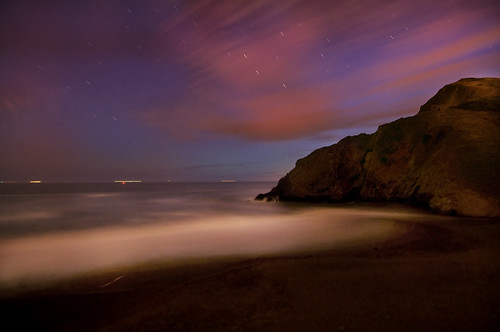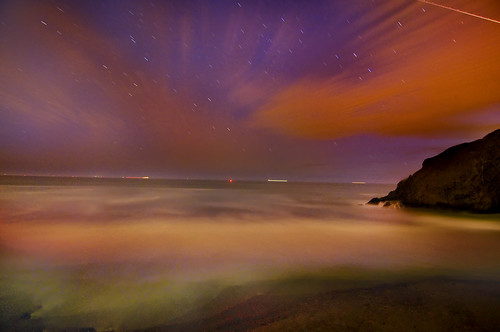We’ve had a couple of spells of really warm weather lately. This is an unusual pattern for the San Francisco Bay area in summer. It is well known that summer weather in San Francisco is often cold and foggy.
On one of these hot and sultry summer days Mark and I started down the trail for Tennessee Beach well after sunset. It was night by the time we reached the ocean. The stars were out and the moon hadn’t risen yet. It was cool and relaxing after the hot day sitting on a ledge above the beach in the darkness.
View this image larger.
I made four exposures while we sat and chatted. Everything looked dark, so I was surprised to see oodles of color in the LCD screen after each exposure. No matter how many times this happens, it always surprises me. In an apparently dark and monochrome world, there are transcendentally beautiful colors.
Vincent van Gogh put it this way: “It often seems to me that the night is much more alive and richly colored than the day.”
View this image larger.
Where do the colors in these images come from? I’ve two theories: possibly the colors in the clouds are ambient light from the city of San Francisco, reflected off clouds and around the bend. Also, some of the colors may be left over from the sunset. I’ve noticed that these colors do grow less vivid as the night progresses.
Our human eyes simply don’t have great sensitivity to the light waves that are present after sunset. (Vincent van Gogh may have been an exception.) Digital sensors do, and maybe animals of the night see these colors as well.
View this image larger.
At a recent workshop I gave, I was asked whether I worked to recreate a scene the way I saw it when I was there. I answered, to a certain amount of gasping, that actually I didn’t care what a scene I photographed “really” looked like; my concern was for the way my imagery came out.
Of course, the merits of photographic fidelity to a subject depend on the goal of an image. Journalistic photographers and documentary photographers are correctly held to a standard of recreating the actual look of their subjects. On the other hand, advertising photographers have the intentional goal of misleading by exaggerating the visual benefits of the products they shoot. I believe, as a photographer with the stated goal of creating art, that what “was there” when I took the original photo is essentially irrelevant.
One reason I use the term “image” to describe the pictures I make, rather than “photo” or “photograph”, is to say that my work cannot necessarily be regarded as a literal depiction.
It takes work to tease these colors out of my RAW files. True, I couldn’t tease them at all if something wasn’t there in the first place. But still, in someone else’s hands these images would be processed very differently.
For me, I care far more about the final visual result than the classification of the technology used to create the image. I’d be happy to use digital photography and post-processing to make night landscapes in the tradition of van Gogh’s magnificent Starry Night. What you see is not always what you get.
View this image larger.
[All images Nikon D300, ISO 100, tripod mounted. From top to bottom: (1) 12-24mm Zoom lens at 12mm (18mm in 35mm terms), 180 seconds at f/5.6; (2) 12-24mm Zoom lens at 12mm (18mm in 35mm terms), 180 seconds at f/5.6; (3) 10.5mm digital fisheye, 180 seconds at f/5.6; (4) 10.5mm digital fisheye, 903 seconds (about 15 minutes) at f/11.]




Pingback: Photoblog 2.0: » Photoblog 2.0 Archive: » Night Vortex